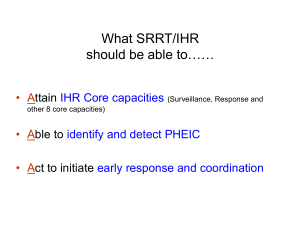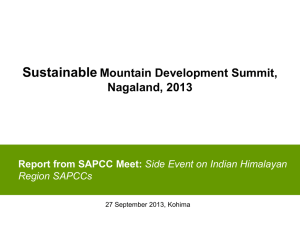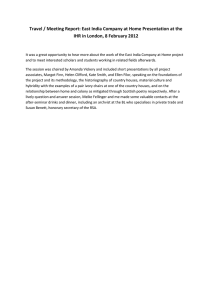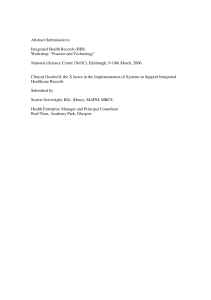IHR Monitoring Framework: Checklist and Indicators for Monitoring Progress in
advertisement
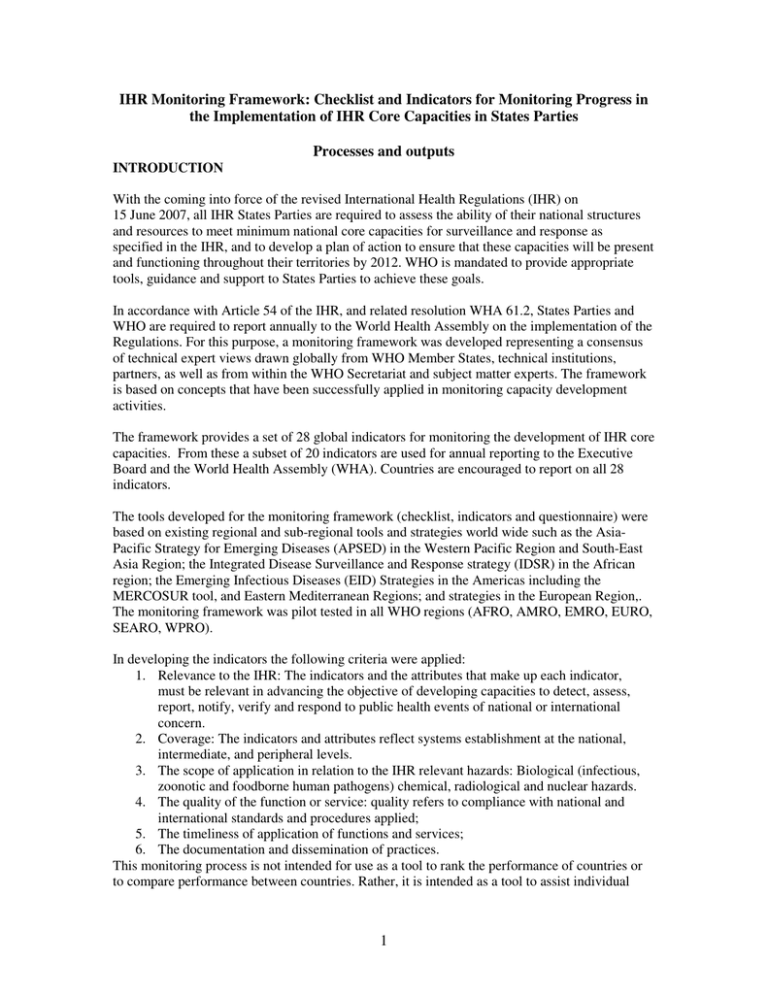
IHR Monitoring Framework: Checklist and Indicators for Monitoring Progress in the Implementation of IHR Core Capacities in States Parties Processes and outputs INTRODUCTION With the coming into force of the revised International Health Regulations (IHR) on 15 June 2007, all IHR States Parties are required to assess the ability of their national structures and resources to meet minimum national core capacities for surveillance and response as specified in the IHR, and to develop a plan of action to ensure that these capacities will be present and functioning throughout their territories by 2012. WHO is mandated to provide appropriate tools, guidance and support to States Parties to achieve these goals. In accordance with Article 54 of the IHR, and related resolution WHA 61.2, States Parties and WHO are required to report annually to the World Health Assembly on the implementation of the Regulations. For this purpose, a monitoring framework was developed representing a consensus of technical expert views drawn globally from WHO Member States, technical institutions, partners, as well as from within the WHO Secretariat and subject matter experts. The framework is based on concepts that have been successfully applied in monitoring capacity development activities. The framework provides a set of 28 global indicators for monitoring the development of IHR core capacities. From these a subset of 20 indicators are used for annual reporting to the Executive Board and the World Health Assembly (WHA). Countries are encouraged to report on all 28 indicators. The tools developed for the monitoring framework (checklist, indicators and questionnaire) were based on existing regional and sub-regional tools and strategies world wide such as the AsiaPacific Strategy for Emerging Diseases (APSED) in the Western Pacific Region and South-East Asia Region; the Integrated Disease Surveillance and Response strategy (IDSR) in the African region; the Emerging Infectious Diseases (EID) Strategies in the Americas including the MERCOSUR tool, and Eastern Mediterranean Regions; and strategies in the European Region,. The monitoring framework was pilot tested in all WHO regions (AFRO, AMRO, EMRO, EURO, SEARO, WPRO). In developing the indicators the following criteria were applied: 1. Relevance to the IHR: The indicators and the attributes that make up each indicator, must be relevant in advancing the objective of developing capacities to detect, assess, report, notify, verify and respond to public health events of national or international concern. 2. Coverage: The indicators and attributes reflect systems establishment at the national, intermediate, and peripheral levels. 3. The scope of application in relation to the IHR relevant hazards: Biological (infectious, zoonotic and foodborne human pathogens) chemical, radiological and nuclear hazards. 4. The quality of the function or service: quality refers to compliance with national and international standards and procedures applied; 5. The timeliness of application of functions and services; 6. The documentation and dissemination of practices. This monitoring process is not intended for use as a tool to rank the performance of countries or to compare performance between countries. Rather, it is intended as a tool to assist individual 1 countries to monitor progress towards meeting the core capacity requirement of the IHR and address gaps identified. The core capacities, hazards and points of entry The IHR monitoring process involves the assessment of implementation of eight core capacities, the development of capacities at points of entry and for IHR-related hazards notably biological (zoonotic, food safety and other infectious hazards), chemical, radiological and nuclear. The core capacities reflect the operational meaning of the capacities required to detect, assess, notify and report events, and to respond to public health risks and emergencies of national and international concern as stipulated in Articles 5 & 13, and Annex 1. The consensus process identified the core capacities as: Core capacity 1: National legislation, policy and financing Core capacity 2: Coordination and National Focal Point (NFP) communications Core capacity 3: Surveillance Core capacity 4: Response Core capacity 5: Preparedness Core capacity 6: Risk communication Core capacity 7: Human resources Core capacity 8: Laboratory Data on country status for these capacities is collected by means of a data collection form (questionnaire) that is available on the internet as a "fillable" PDF form or as a printable PDF to be completed and could also be submitted to WHO in hard copy. This questionnaire was developed in 2010. It has been updated in 2011 and replaces the States Parties Questionnaires sent to NFPs in 2008, 2009 and 2010. Data analysis: For each core capacity, four distinct capability levels are characterized: Capability Level < 1 (the foundational level) includes attributes that are key to the development of the inputs and processes needed for the implementation of the IHR. Capability Level 1 is generally characterized as a ‘moderate’ level and attributes listed here include the ‘inputs and processes’ needed to build or maintain IHR core capacities. Capability Level 2 represents a ‘strong’ technical capacity and a high level of performance with defined public health outputs and outcomes. Capability Level 3 represents an advanced level of capabilities and achieving a ‘reference model’ of capability1. States Parties are expected to meet the core capacity requirements by 2012. States Parties may obtain a two-year extension to the 2012 deadline for fulfilling these capacity obligations on the basis of a justified need and an implementation plan to be reported to WHO. In exceptional circumstances, a further limited extension may be available (Articles 5.2 and 13.2 of the IHR). 1 This involves the generation of information, products and tools that reflect examples of models of best practices and standards that can be adopted or shared globally. In order for an attribute to be scored at Level 3, a good explanation of products and tools and URLs of the relevant web sites should be included in the checklist. This will further enable sharing of best practices, products and tools. 2 Reports and information products The reports for each country will give an indication of their status in implementing the IHR at a point in time, as well as progress over time for each of the 8 core capacities, hazards and at designated PoE. As circulated to all IHR-NFP's for 2010, these include Individual detailed country reports (Recipients: Country IHR-NFP, WHO Country Office, Regional Office and HQ) Progress report of individual States Parties by core capacities; temporal comparison of progress within individual core capacity (Recipients: Country IHR-NFP, WHO Country Office, WHO RO, HQ) WHO Regional Office aggregate report of countries in the specific region (Recipients: WHO Regional Office) Aggregate progress report of State Parties (Recipients: World Health Assembly, Executive Board Members, WHO) Country profiles on the status of core capacities as well as charts, and graphs, will be available. Countries and WHO will have access to this information. Any country will only have automatic access to that country's data. Differences in States Parties report 2008/2009 and current version of report Table 1 shows the main differences between the 2009 and the current version of the States Parties Reports Area of States Parties Report 2008/2009 States Parties Report 2011 Change 1. Legislation and Policy Number of 1. National IHR Focal Point (NFP), 2. IHR coordination Sections 2. National Legislation and Policy 3. PoE 3. Surveillance 4. Response 4. National core capacities in surveillance and response 5. Preparedness 6. Risk Communications 5. Financial resource gaps 6. National legislation, regulations and 7. Human Resources administrative requirements for 8. Laboratory 9. POE implementation 10. Hazards of the IHR 7. Participation in relevant 10.1. Zoonotic international arrangements 10.2. Food safety 10.3. Chemical emergencies 8. Structured to take into account all 10.4. Radiological emergencies core capacities and hazards Scope Less emphasis on major IHR Greater emphasis on need for relevant hazards (chemical, consultation with relevant sectors/hazards radiological, zoonotic, and food and levels to reflect comprehensive safety) capacity of Member States Purpose of data Data collection only for Data is collected primarily to assist the collection reporting to WHA country in monitoring their status with respect to IHR capacities. A secondary purpose is to allow WHO secretariat to identify technical areas requiring support at country, regional or global levels. Finally a subset of the data collected will provide a means for the WHA to monitor progress in country implementation of the IHR in the area of core capacities. 3 The following 20 indicators have been selected for reporting to WHA: 1. Legislation, laws, regulations, administrative requirements, policies or other government instruments in place are sufficient for implementation of IHR. 2. A mechanism is established for the coordination of relevant sectors in the implementation of the IHR. 3. IHR NFP functions and operations are in place as defined by the IHR (2005). 4. Indicator-based surveillance includes an early warning function for the early detection of a public health event. 5. Event-based surveillance is established. 6. Public health emergency response mechanisms are established. 7. Infection prevention and control (IPC) is established at national and hospital levels. 8. A Multi-hazard National Public Health Emergency Preparedness and Response Plan is developed. 9. Priority public health risks and resources are mapped. 10. Mechanisms for effective risk communication during a public health emergency are established. 11. Human resources are available to implement IHR core capacity requirements. 12. Laboratory services are available to test for priority health threats. 13. Laboratory biosafety and laboratory biosecurity (biorisk management) practices are in place. 14. General obligations at PoE are fulfilled. 15. Effective surveillance and other routine capacities are established at PoE. 16. Effective response at PoE is established. 17. Mechanisms for detecting and responding to zoonoses and potential zoonoses are established. 18. Mechanisms are established for detecting and responding to foodborne disease and food contamination. 19. Mechanisms are established for the detection, alert and response to chemical emergencies. 20. Mechanisms are established for detecting and responding to radiological and nuclear emergencies. Numerous consultations were held with technical experts who are all gratefully acknowledged, from WHO Member States (Brazil, Canada, the Democratic Republic of the Congo, France, Georgia, Japan, Kenya, Lebanon, the Philippines, Thailand, Uganda, the United States of America and Yemen), regional offices and partner institutions The World Health Organization (WHO) is grateful to the following Member States for participating in the field-testing of this document: Bahrain, Cambodia, Canada, China, Egypt, Ghana, India, the Lao People’s Democratic Republic, Nepal, Switzerland and Uganda. 4
